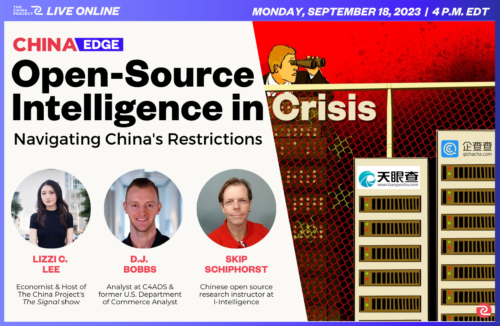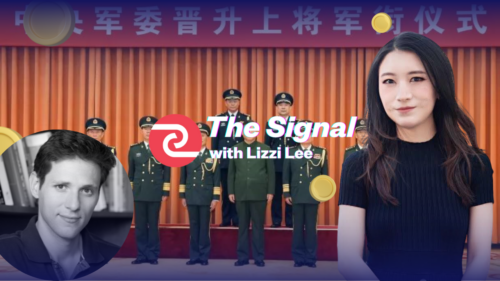ASPI research: China trumps U.S. in key technology research | The Signal with Lizzi Lee
Dr. Jamie Gaida is a senior analyst at the Australian Strategic Policy Institute (ASPI) specializing in statistics, research ethics, data science, computer algorithms, software development, and machine learning. He recently published a piece on The Critical Technology Tracker and how Western democracies are losing the global technological competition.

Below is a transcript of the video:
Lizzi Lee: Hello and welcome to this episode of Live With Lizzi Lee. I’m your host, Lizzi. Joining me today is Mr. Jamie Gaida. Jamie is a senior analyst at the Australian Strategic Policy Institute, ASPI. Thank you so much for joining me, Jamie.
So, Jamie, according to a new report from your team at ASPI, Chinese researchers are actually leading your American counterparts in a study of 37 out of 44 critical technologies. I wonder if you can help our audience understand the methodology of the study.
Jaime Gaida: Yeah, Thank you so much. So what we did is we identified research papers on each of these 44 critical technology areas. We did that using a website database of research papers, and it’s one of the largest databases of its kind in the world and heavily used by researchers working in similar areas.
And what it does is it tracks all the research that’s published in thousands of journals and also citations of those papers. And a citation is when one scientific paper refers to another paper in its bibliography. What we did is we looked at the past five years of publications and we sliced off the top 10% of the most highly cited papers. And so that represents papers that other scientists are referencing, and that indicates their impact. We call them high-impact research papers for those papers in the top 10%. We then identified the country of origin of each of the authors on the paper, and we apportioned credit for each paper. We divided it by the number of authors on a paper. So if there were four authors, we divided the credit in four and according to which country they were affiliated with, we then yeah, and then we just added up what percentage of these high impact papers were coming from in each country.
Lizzi: So I wonder if you can briefly review what are the key areas in which Chinese researchers are actually leading American researchers? Do we know why Chinese researchers can make advances in those areas?
Jaime Gaida: Yeah, thanks so much. So some of the key areas include nanoscale materials and manufacturing, advanced coatings and smart materials, and also 5G and six G communication research. Some other interesting areas in energy and environment included electric batteries where China was publishing 65% of the top 10% of most high-impact papers and also things like hydrogen and ammonia for power and supercapacitors.
Lizzi: Right. The report also notes the important caveat. So China has struggled to turn many of its research breakthroughs into manufacturing success. And China’s commercial and military sectors still mostly rely on foreign suppliers. How do you expect Beijing’s policymakers to break those bottlenecks?
Jaime Gaida: Yeah. Thank you. That’s a really insightful question. We make reference to these several times throughout the report, and we add that like you said, an important caveat that just because you’re doing high-impact research doesn’t mean you currently have manufacturing capability or defense capability in that same area. But what we do think is it’s a really important leading indicator of where capability might get to within, say, five or ten years from now. And in the report, we discuss the manufacturing of jet engines, which there have been reports of quality and reliability problems with Chinese-manufactured jet engines. However, that is an area that they’re leading in research. So we think that’s one part of the plan that the CCP is enacting in order to address these problems. So the first is prioritizing investments and energy into research in an area such as jet engines.
The Chinese government has also recognized the choke point issue of, for example, being reliant on the US and Swedish steel suppliers for precision grade stainless steel, which is required for the bearings within jet engines. And we would expect that now that they’re leading in the research areas, they are going to try and feed those advances into their manufacturing base and put some significant effort into addressing these reliability problems. And already they seem to be making some strides in those areas. And domestically manufactured jet engines are starting to appear in fighter jets.
Lizzi: As you know, U.S. lawmakers are very concerned about China’s central city monopoly in many of the global supply chains in advanced industries. For example, you know, global battery manufacturing or refining capacity for rare earth minerals. I wonder, what’s your suggestion to U.S. lawmakers? How can the United States catch up in its tech race with China, given that Chinese researchers are actually leading United States research in many fields?
Jaime Gaida: Absolutely. And as you point out, the electric battery was one of the areas in which there was one of the strongest leads in Chinese research. Somewhere around approximately 60% of the research in that area comes out of China. And these findings should be a significant wake-up call to democratic nations. And they need to be a strategic step up in critical technology research, but also translation into manufacturing, and that is going to require substantial collaboration across different countries.
That could be leveraged through already existing international agreements. The EU, the Quad, and AUKUS are just a couple of examples. And where we’re going to need to see much deeper collaboration between partners. In the report. We make 23 recommendations, quite forward-leading, quite ambitious recommendations, one of which is technology visas, critical technology visas to allow both young and established researchers to move more easily between countries so that we can have a better exchange of knowledge and research expertise in these areas.
We also call for large sovereign wealth funds to prioritize investment in the commercialization of existing technology strengths. And we also call for a more focused effort in intelligence strategies and put forward the idea of a five Eyes plus Japan collaboration in terms of intelligence sharing and starting with open source intelligence to get a better handle on where China currently is up to, not only in the research but also in the commercialization and manufacturing in this really important area. On the question of rare earth materials, I direct your audience to have a look at some of the work done by an ASPI colleague at John Coyne who does a lot of work, particularly on rare earth metals and supply chains. Some great material there.






